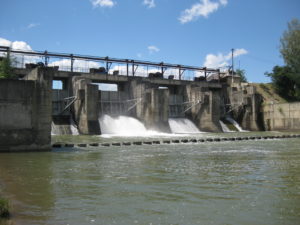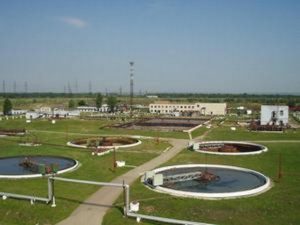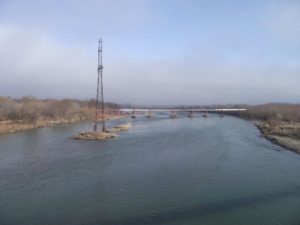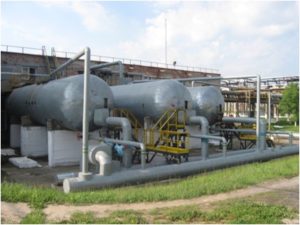Department of production support
Department of production support
PRODUCTION SUPPORT DEPARTMENT
Water supply and waste water disposal plant
 In 1961, water supply and waste water disposal plant was started in order to provide water supply and drainage of the petrochemical complex in Kalush.
In 1961, water supply and waste water disposal plant was started in order to provide water supply and drainage of the petrochemical complex in Kalush.
The water supply and waste water disposal plant is designed to provide potable and industrial water to the structural units of KARPATNAFTOCHIM Ltd. and other enterprises, as well as to remove rainwater from them, transporting service and industrial waste water to treatment facilities.
The plant includes the river water clarification station, potable water filtration station, system of networks and pumping stations of water supply and waste water disposal.
The river water clarification station was put into operation in 1974. The design capacity of the clarification station is 100 ths. m3/day, achieved capacity – 100 ths. m3/day. Production is based on the method of water coagulation, followed by water precipitation in horizontal settling tanks.
The potable water filtration station was put into operation in 2013. The design capacity of the filtration station is 6,0 ths, m3/day, achieved capacity – 6,0 ths. m3/day. Water is purified on pressure high-rate filters by contact coagulation. Water sterilization, as well as disinfection of filters is carried out with sodium hypochlorite solution.
The water supply system includes underground and above-ground pipelines and pumping stations. Potable water is supplied to consumers by underground pipelines with a diameter of 350 mm, and industrial water by underground and above-ground pipelines with a diameter of 600 mm and 800 mm.
The waste water disposal system includes underground pipelines, manifolds and sewage pumping stations. Service and organic waste water from the production plants is transported to the treatment facilities by discharge pipelines through sewage pumping stations. Acid-alkaline and hypochlorite waste water from the production plants is sent to waste water treatment plants by gravity manifolds.
Neutralization and treatment of industrial sewage water plant
 Neutralization and treatment of industrial sewage water plant (NTISW plant or treatment facilities) of KARPATNAFTOCHIM Ltd was start up in 1964.
Neutralization and treatment of industrial sewage water plant (NTISW plant or treatment facilities) of KARPATNAFTOCHIM Ltd was start up in 1964.
Design capacity of the plant:
– on hypochlorite wastes – 200 m3/day
– on acid and alkali industrial wastes – 16522 m3/day
– on service-utility and organic wastes – 64660m3/day
Number of process lines – 3
Method of production – continuous.
In 1970 the hypochlorite wastes decomposition site was modernized under the innovative proposal No. 119-70 in order to improve the economic indicators and improve the conditions of labour safety.
Modernization and extension of the neutralization and treatment of industrial sewage water was carried out in 1989. The design of modernization and extension was prepared by the institute UKRVODOKANALPROEKT, Kyiv.
In 2007, a replacement was carried out at the site of mechanical treatment of domestic sewage with the installation of 2 coarse filtering drum-screw screens of the German company HUBER. No changes of process flow parameters were required by the project No. 9584.
In 2011, the replacement was made at the unit of mechanical sludge dewatering: ALDEC G2-60 Smart Decanter centrifuge was put into operation.
In July 2015, in accordance with the project No. 1814, completed by the design department of KARPATNAFTOCHIM Ltd., a liming unit was put into operation.
In November 2015, in accordance with the project No. 1966 ‘Installation of 2MVG-47 “Vykhor” cooling tower”, completed by the design department of KARPATNAFTOCHIM Ltd., the modernization of air compressing unit to was carried out in terms of replacement of air blower cooling system.
Long-distance product pipeline plant
Long-distance product pipeline plant is designed for technical operation of the ethylene receiving and pumping station with the linear part of the ethylene pipeline “Kalush-Western border” and long-distance product pipeline “Drohobych-Kalush”, as well as for receiving, storage, transportation and record of raw materials and products (diesel fuel, ethylene) in the specified volume, nomenclature, assortment and quality.
The plant operates:
• Long-distance product pipeline “Drohobych-Kalush” since 1990, design capacity 490 thousand tons/year, achieved capacity – 720 thousand tons/year. The diameter of the product pipeline is 219 mm, the length is – 84.7 km. The facility is located on the territory of the Lviv region (Drohobych, Stryi districts) and Ivano-Frankivsk region (Dolyna, Kalush districts, the city of Kalush).
In 1995, MOPS was reconstructed in order to ensure the supply of diesel fuel from the long-distance product pipeline “Strashevychi – Drohobych” of the State Enterprise “PRYKARPATZAKHIDTRANS” to the long-distance product pipeline “Drohobych – Kalush”.
• ethylene receiving and pumping station with the line section of ethylene pipeline “Kalush-Western border” since 1974, the design capacity of ethylene transportation – 300 thousand tons per year, the achieved capacity of ethylene transportation – 130 thousand tons per year. The diameter of ethylene pipeline is 325 mm, the length – 204.6 km. The facility is located on the territory of the Transcarpathian region (Berehove, Irshava, Mizhhiria districts) and Ivano-Frankivsk region (Dolyna, Rozhniativ, Kalush districts, the city of Kalush).
Ethylene receiving and pumping station is designed to receive the gaseous ethylene from the hydrocarbon bottling plant or from the pyrolysis plant, to compress and separate the pyrogas of ethylene and polyethylene production and to transport to the vinylchloride production plant and to transport via the Kalush-Western border pipeline at the Tizsa Chemical Plant (Hungary)
The basis of design provides for transportation of ethylene from the Tizsa Chemical Plant to Kalush Chemical Plant.
In 1986, Kalush Production Association “Vinylchloride” put into operation its own production of ethylene and propylene. At the same time, the line section of ethylene pipeline was reconstructed and the direction of ethylene supply to Hungary was changed.
In 2010, the ethylene metering station was reconstructed at the 18th km of ethylene pipeline route. The reconstruction was carried out in order to provide ethylene metering when supplying it from ethylene and polyethylene production of KARPATNAFTOCHIM Ltd. to Tizsa Chemical Plant, as well as to the productions KARPATNAFTOCHIM Ltd. from the Tizs
a Chemical Plant.
Steam and gas supply plant.
In 1967, together with the construction of Kalush CHPP at the Kalush Chemical and Metallurgical Works, a plant designed to supply heat energy of production subdivisions was established, which, after repeated re-constructions and reorganizations, became a part of the production support department.
The main task of the plant is to ensure timely and uninterrupted supply of heat energy (steam), heating water and natural gas to the structural units of KARPATNAFTOCHIM Ltd. and outside organizations, as well as return a high-quality condensate to CHP.
The plant includes: pipeline networks of steam, heating water, heat supply station, distribution high and medium pressure gas pipelines, gas control units and reinforced concrete piers of heat and material pipeline.
The steam with a temperature of 300 ºС and a pressure of 13 kgf/cm2 is transported via interfacility pipelines from Kalush CHP to the production site of the chemical plant and ethylene and polyethylene production. The total length of steam pipelines is 9.3 km. The production site of chemical plant comprises the heat supply station where the cooling units (CU) and reduction-cooling units (RCU) are installed, which make it possible to generate the steam of required temperature and pressure. After heat supply station, the steam with pressure of 12kgf/cm2 and 6kgf/cm2 is transported to S-PVCR and CS production plants for process needs. The total length of steam pipelines at the chemical plant site is 6.4 km.
To provide heating of industrial and amenity buildings at the chemical plant site in the heating season, the heat supply station includes heating water preparation unit. Heating water is heated by steam in the shell and tube heat exchangers and is supplied to consumers via the district heating network using the network pumps. The total length of district heating networks is 7.7 km.
In order to collect condensate, which is generated when steam is used by process plants, the condensate house is provided in the heat supply station. The condensate from the plants is collected in metal tanks with a total volume of 350 m³, and after quality confirmation the condensate from the tanks is supplied back to Kalush CHP via condensate pipeline using the pumps.
The steam and gas supply plant includes the piers of heat and material pipelines with a total length of 7.5 km.
Natural gas with a pressure of 8 kgf/cm2 from Kalush-2 gas distribution station (GDS) is transported by high pressure distribution gas pipelines to gas control units (GCU) of S-PVCR and CS production and ethylene & polyethylene production
In GDS, natural gas is reduced to a pressure of P = 3.0 kgf/cm2 and transported via medium pressure gas pipelines to consumers:
– via gas pipeline from GDS of S-PVCR and CS production to the vinylchloride production plants and from S-PVCR production,
– via gas pipeline from GDS of ethylene & polyethylene production to the units of hydrocarbon bottling, pyrolysis, pyrogas compression and separation, from the production of ethylene halogen derivatives, their polymers and copolymers. Total length of gas pipelines is 6.9 km.
Olefins production plant Plant capacity: 250 000 tpa on ethylene 117 052 tpa on propylene 101 166 tpa on benzene Year of start-up – 1986. Process developer: Company Linde, Germany. Process technology description Feedstock for ethylene production are naphtha, acyclic hydrocarbons, LPG, butane cut and recycle cuts С2, С3, С4, С5. Polyolefin production plant comprises […]
Vinylchloride production plant Plant capacity: 300 000 tpa Year of start-up: 1975 1996 – modernization Design: company Uhde, Germany Process technology description Vinylchloride production comprises of units for crude EDC production by means of direct ethylene chlorination and oxidative ethylene chlorination where hydrogen chloride obtained at pyrolysis is used in reactors with catalyst fluid bed. […]



